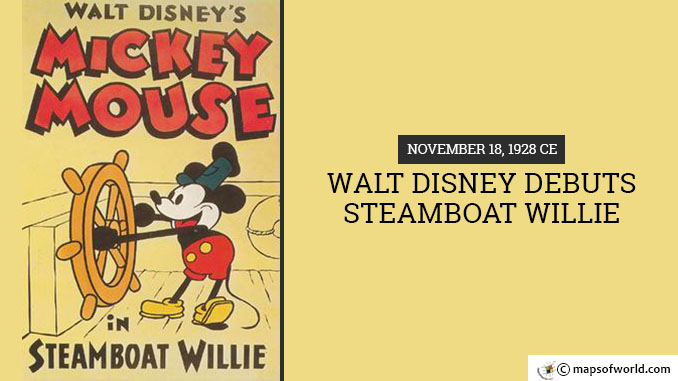A pair of world icons hit the silver screen for the first time at the Colony Theater in New York City on November 18, 1928: Mickey and Minnie Mouse starred in Steamboat Willie, one of the earliest examples of a motion picture soundtrack working in sync with an animated feature. Funded by Walt Disney, the 8-minute cartoon launched his career and led to the development of an entertainment juggernaut. Widely regarded as Mickey and Minnie’s first appearance on film, in truth the pair showed up in a handful of screen tests several months before. The process to make Steamboat Willie began when Walt Disney approached his brother and co-producer, Roy, about his fascination with a movie called The Jazz Singer in 1927. (The two-hour musical featured the first synchronized soundrack in history.) Though at least two other animated shorts had sound — one in 1924 and the other just weeks before Steamboat Willie was released — none of them had much in the way of financial success. What really set the short cartoon apart and eventually led to its commercial success was the process by which the sound was married to the moving image. Costing just under $5,000, the two-month effort started with the animators. Produced in large part by Ub Iwerks, a team of three created drawings to depict the interaction between Mickey and his boss, boat captain Pete, while they attempt to move some cattle downstream, picking up Minnie along the way. Producing the sound required a different method than others used. Thinking through the best way to produce a “true to life” connection between the music and the cartoon, Roy Disney moved the projector outside the makeshift recording studio, shooting the images onto a white bed sheet hung by Iwerks. Using pots and pans, in addition to their own voices and basic instruments, a few employees created the rough cut. The first audience would be a group of wives and friends. Pleased with the response, Walt Disney would later say, “It was terrible, but it was wonderful!” Eager to have a more polished product, he headed to New York City and hired professionals to help him add the finishing touches to the soundtrack. Though the first try would fall short of expectations, Walt Disney sold his car and financed another attempt, using a bouncing ball to maintain rhythm and ensure the audio moved along at the same pace as the video. Satisfied with the result, Walt Disney managed to secure Celebrity Productions as the distributor for a two-week run at the Colony Theater before the upcoming movie Gang War. When it first appeared on November 18, 1928, Steamboat Willie enchanted audiences. Roars of laughter greeted each showing, allowing the animated picture to outshine the full-length feature that followed it. Beyond introducing Mickey and Minnie, two of the most beloved characters ever committed to celluloid, to a wider audience, Steamboat Willie saved the nearly-bankrupt Walt Disney Studio from oblivion. Beyond just the innovation, its commercial success funded more shorts and paved the way for later movies like Snow White and the Seven Dwarfs almost a decade later. Owing to its deep cultural influence, the cartoon was designated for preservation by the National Film Registry of the United States in 1998. Also On This Day: 1307 – According to legend, William Tell shoots an apple off his son’s head 1626 – St. Peter’s Basilica is consecrated in Vatican City 1883 – The American and Canadian railroads institute five time zones for North America 1978 – Followers of Jim Jones and the People’s Temple cult commit mass suicide in Jonestown, Guyana — over 900 are dead 1993 – A new constitution is approved by 21 political parties in South Africa
November 18 1928 CE – Walt Disney Debuts Steamboat Willie
A pair of world icons hit the silver screen for the first time at the Colony Theater in New York City on November 18, 1928: Mickey and Minnie Mouse starred…
615
